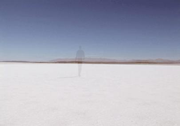November 09, 2006
Upgrade! Lisbon
![]()
BLINDSPOT
Upgrade! Lisbon :: November 16, 2006, 19:00 :: Blindspot by Herwig Turk, Paulo Pereira and Günter Stöger :: 19:00 @ Lisboa20 Arte Contemporânea Rua Tenente Ferreira Durão 18B (Campo de Ourique).
Blindspot is an interdisciplinary research project about perception, developed by Herwig Turk, Dr. Paulo Pereira and Günter Stöger in cooperation with Beatriz Cantinho, Bärbel Buck, Patrícia Almeida, and Dr. Miguel Castelo Branco. The project aims at investigating perception in a broader context as well as its circumstances, its determinants and its contingencies. The proceedings in the research laboratories in vision sciences are translated into different settings, thereby creating a meta-language that crosses traditional boundaries between science and art. At the same time, a new heterotopic space for experimentation is created where objects, gestures and language separated from their supporting context gain new dimensions. The approach used by the authors adopts the formal structure of a research project, starting with the hypothesis that Science represents an imperfect means whereby perception is used as a privileged means o assess reality (“an improved means to an unimproved end”, Thoreau).

The overall approach of Blindspot is based on a long-term interchange of knowledge methods and proceedings of sciences and arts. “Perception is the process whereby sensory stimulation is translated into organized experience”, Encyclopaedia Britannica). Vision sciences tend to focus on the process of sensory stimulation: from the eye to the brain or from the photon to the image. The anatomical, physiological, neurological and biochemical research can convey the means to gather a great amount of information that agglomerates in large volumes and treaties. However precise, a vast amount of information is neglected or is actively translocated to a place outside of the laboratory by the application of the scientific methods and procedures. What remains, are contaminations from the “outside world” and are largely the subject-matter of this interdisciplinary project. Within the project perception is defined as a proposition that includes the “organized experience” within and among various human and non-human elements. These elements connect and communicate through incidents and create a reality that can only be understood in a very limited timeframe.
The method used by the research team relies on a strong interaction and interference between the organic elements and the instances that contextualize the received information. One cannot say where the Organ ends and the processing starts! (Oswald Wiener).
These interactions are highly variable and strongly depend on individual dispositions and environmental factors . Thus, a “real world” exists just as a helpful construction to interpret ephemeral individual perceptions.
Individual perception cannot be observed or interpreted as isolated, but rather as something that is distributed within group structures (persons, objects, environments). Each individual perceives himself and his daily environment through the reflections and reactions of others. Every single person is connected to a floating system of information and a clear line cannot be draw to separate individuals from others nor from their own surroundings.
Science aims at a universal language supported by inertia referential. The scientific language is highly coded and the associations between words, concepts and the corresponding entities in the “real world” are often blurred by the complex system of references used. The scientific systems of references include necessarily established conventions comparable to GMT (Greenwich mean time) or the null meridian, in an attempt to identify standards that make measurements possible and universal.
A main goal in this project is to identify calibration standards and reference points that are critical in influencing individual perception. Once such points of reference are identified they can be easily manipulated by deconstructing its own fundaments and by displacing them into a different context/setting. This approach questions the fallibility of the scientific conventions and highlights the importance and contribution of social and individual constructions (constellations) to what is perceived as a scientific through or a scientific fact. More importantly, the founding elements and corner stones of the scientific method are man-made and became less abstract as the project emphasizes and brings to center-stage those structural elements that are both invisible and – thought of as - infallible in daily scientific routines.
This goal can be accomplished by a variety of procedures, including the dislocation of both observer and object of observation to different scenarios where common references are no longer obvious and where the elements that support perception are often absent. Experimentally, this approach creates the field where different categories of knowledge meet and reveals the interdisciplinary nature of the project.
Posted by jo at November 9, 2006 01:37 PM
